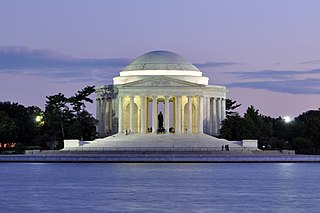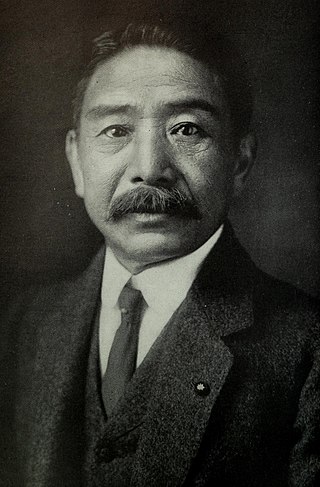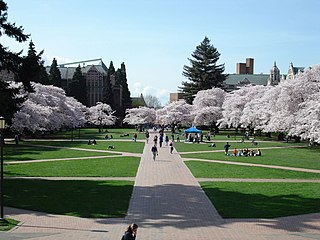
The cherry blossom, or sakura, is the flower of trees in Prunus subgenus Cerasus. "Sakura" usually refers to flowers of ornamental cherry trees, such as cultivars of Prunus serrulata, not trees grown for their fruit. Cherry blossoms have been described as having a vanilla-like smell, which is mainly attributed to coumarin.

The Jefferson Memorial is a presidential memorial in Washington, D.C. It was built between 1939 and 1943 in honor of Thomas Jefferson, the principal author of the United States Declaration of Independence, a central intellectual force behind the American Revolution, a founder of the Democratic-Republican Party, and the nation's third president.

West Potomac Park is a U.S. national park in Washington, D.C., adjacent to the National Mall. It includes the parkland that extends south of the Lincoln Memorial Reflecting Pool, from the Lincoln Memorial to the grounds of the Washington Monument. The park is the site of many national landmarks, including the Korean War Veterans Memorial, Jefferson Memorial, Franklin Delano Roosevelt Memorial, George Mason Memorial, and the Martin Luther King Jr. Memorial.

The George Mason Memorial is a memorial to Founding Father George Mason, the author of the Virginia Declaration of Rights that inspired the United States Bill of Rights. The Memorial is located in West Potomac Park within Washington, D.C. at 24 E Basin Drive SW, which is a part of the Tidal Basin. Authorized in 1990, with a groundbreaking in 2000 and dedication in 2002, the memorial includes a sculpture of Mason, a pool, trellis, circular hedges, and numerous inscriptions. It was the first memorial in the Tidal Basin area to be dedicated to someone who was not a former President of the United States.

The National Cherry Blossom Festival is a spring celebration in Washington, D.C., commemorating the March 27, 1912, gift of Japanese cherry trees from Mayor Yukio Ozaki of Tokyo City to the city of Washington, D.C. Ozaki gave the trees to enhance the growing friendship between the United States and Japan and also celebrate the continued close relationship between the two nations. Large and colorful helium balloons, floats, marching bands from across the country, music and showmanship are parts of the Festival's parade and other events.

Hains Point is located at the southern tip of East Potomac Park between the main branch of the Potomac River and the Washington Channel in southwest Washington, D.C. The land on which the park is located is sometimes described as a peninsula but is actually an island: the Washington Channel connects with the Tidal Basin north of the park and the Jefferson Memorial. The island is artificial: it was built up from Potomac dredging material from 1880 to 1892.

Independence Avenue is a major east-west street in the southwest and southeast quadrants of the city of Washington, D.C., in the United States, running just south of the United States Capitol. Originally named South B Street, Independence Avenue SW was constructed between 1791 and 1823. Independence Avenue SE was constructed in pieces as residential development occurred east of the United States Capitol and east of the Anacostia River. Independence Avenue SW received its current name after Congress renamed the street in legislation approved on April 13, 1934. Independence Avenue SW originally had its western terminus at 14th Street SW, but was extended west to Ohio Drive SW between 1941 and 1942. The government of the District of Columbia renamed the portion of the road in the southeast quadrant of the city in 1950.

East Potomac Park is a park located on a man-made island in the Potomac River in Washington, D.C., United States. The island is between the Washington Channel and the Potomac River, and on it the park lies southeast of the Jefferson Memorial and the 14th Street Bridge. Amenities in East Potomac Park include the East Potomac Park Golf Course, a miniature golf course, a public swimming pool, tennis courts, and several athletic fields. The park is a popular spot for fishing, and cyclists, walkers, inline skaters, and runners heavily use the park's roads and paths. A portion of Ohio Drive SW runs along the perimeter of the park.

The Cherry Blossom Ten Mile Run is an annual 10-mile (16 km) road race in Washington, D.C. Founded in 1973 originally as a precursor training run for elite runners planning to compete in the Boston Marathon, the race has evolved over the years into a local race for runners of all abilities. Nevertheless, it still attracts international running stars such as Catherine Ndereba, Bill Rodgers, John Korir, and Olga Romanova.

The Tidal Basin is a man-made reservoir located between the Potomac River and the Washington Channel in Washington, D.C. The Basin is part of West Potomac Park, is near the National Mall and is a focal point of the National Cherry Blossom Festival held each spring. The nearby Jefferson Memorial, Martin Luther King Jr. Memorial and Franklin Delano Roosevelt Memorial overlook the Basin, which is south of the Washington Monument.

Yukio Ozaki was a Japanese politician of liberal signature, born in modern-day Sagamihara, Kanagawa. Ozaki served in the House of Representatives of the Japanese Diet for 63 years (1890–1953). He is still revered in Japan as the "God of constitutional politics" and the "father of the Japanese Constitution".

Ohio Drive is a street in Southwest Washington, D.C., located in East and West Potomac Parks and bordering the Tidal Basin, Washington Channel, and the Potomac River. It is a central organizing feature of East Potomac Park, providing the only major vehicular route to and through the area. Unlike most roadways named after states in the District of Columbia, Ohio Drive is not an avenue, nor it is heavily used like Wisconsin or Rhode Island Avenues. However, the segment from Independence Avenue to the Rock Creek and Potomac Parkway is an important commuter route.

The International Cherry Blossom Festival is held in Macon, Georgia every spring. Macon, known as the "Cherry Blossom Capital of the World," has around 300,000–350,000 Yoshino Cherry Trees that bloom around the city in late March every year. The festival, held to coincide with the typical blooming period, lasts for ten days and features events for people of all ages. It has been an annual event since 1982, though the 2020 edition was cancelled due to the COVID-19 pandemic.

Eliza Ruhamah Scidmore (1856–1928) was an American journalist and travel writer who authored books on Alaska, Japan, Java, China and India. Her legacy includes serving as the first woman on the board of the National Geographic Society and introducing the idea of planting Japanese cherry trees in Washington, D.C., a vision that became a reality in 1912.

Count Chinda Sutemi was a Japanese diplomat.

The Japanese Lantern is a stone lantern in West Potomac Park, Washington, D.C. It is located next to the Tidal Basin, among the cherry trees first planted in 1912. It is lighted during the annual National Cherry Blossom Festival.
Climate change in Washington, D.C., is marked by rising temperatures, increased rainfall and flooding, and storm surges of the Potomac River. Tourism is affected by shifts in the cherry blossom bloom. The city's government is active in climate adaptation and mitigation efforts.

A Witness Tree is a tree that was present during a grand historical or cultural event of America. The trees got their name from being able to "witness" a historically significant event. Witness trees are centuries old and are known to be of great importance to the U.S. Nation's history. It is unclear how many witness trees there are, but the ones documented are archived in the Library of Congress through the Witness Tree Protection Program.
In the present day, ornamental cherry blossom trees are distributed and cultivated worldwide. While flowering cherry trees were historically present in Europe, North America, and China, the practice of cultivating ornamental cherry trees was centered in Japan, and many of the cultivars planted worldwide, such as that of Prunus × yedoensis, have been developed from Japanese hybrids.

Cherry blossoms play an important role in the city of Seattle, in the U.S. state of Washington. Seattle has more than 1,000 cherry trees donated by Japan as a symbol of friendship. Christine Clarridge of Axios Seattle wrote, "The annual bloom of cherry trees across Seattle symbolizes the end of the dark months and the beginning of spring, drawing residents and swarms of tourists to the city's most popular viewing places." The season's peak varies depending on weather conditions, but generally lasts from January to March.


















